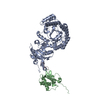+Search query
-Structure paper
| Title | Identification of a carbonic anhydrase-Rubisco complex within the alpha-carboxysome. |
|---|---|
| Journal, issue, pages | Proc Natl Acad Sci U S A, Vol. 120, Issue 43, Page e2308600120, Year 2023 |
| Publish date | Oct 24, 2023 |
 Authors Authors | Cecilia Blikstad / Eli J Dugan / Thomas G Laughlin / Julia B Turnšek / Mira D Liu / Sophie R Shoemaker / Nikoleta Vogiatzi / Jonathan P Remis / David F Savage /   |
| PubMed Abstract | Carboxysomes are proteinaceous organelles that encapsulate key enzymes of CO fixation-Rubisco and carbonic anhydrase-and are the centerpiece of the bacterial CO concentrating mechanism (CCM). In the ...Carboxysomes are proteinaceous organelles that encapsulate key enzymes of CO fixation-Rubisco and carbonic anhydrase-and are the centerpiece of the bacterial CO concentrating mechanism (CCM). In the CCM, actively accumulated cytosolic bicarbonate diffuses into the carboxysome and is converted to CO by carbonic anhydrase, producing a high CO concentration near Rubisco and ensuring efficient carboxylation. Self-assembly of the α-carboxysome is orchestrated by the intrinsically disordered scaffolding protein, CsoS2, which interacts with both Rubisco and carboxysomal shell proteins, but it is unknown how the carbonic anhydrase, CsoSCA, is incorporated into the α-carboxysome. Here, we present the structural basis of carbonic anhydrase encapsulation into α-carboxysomes from . We find that CsoSCA interacts directly with Rubisco via an intrinsically disordered N-terminal domain. A 1.98 Å single-particle cryoelectron microscopy structure of Rubisco in complex with this peptide reveals that CsoSCA binding is predominantly mediated by a network of hydrogen bonds. CsoSCA's binding site overlaps with that of CsoS2, but the two proteins utilize substantially different motifs and modes of binding, revealing a plasticity of the Rubisco binding site. Our results advance the understanding of carboxysome biogenesis and highlight the importance of Rubisco, not only as an enzyme but also as a central hub for mediating assembly through protein interactions. |
 External links External links |  Proc Natl Acad Sci U S A / Proc Natl Acad Sci U S A /  PubMed:37862384 / PubMed:37862384 /  PubMed Central PubMed Central |
| Methods | EM (single particle) |
| Resolution | 1.98 - 2.07 Å |
| Structure data | EMDB-25201, PDB-7smk: EMDB-25228, PDB-7snv: |
| Chemicals |  ChemComp-HOH: |
| Source |
|
 Keywords Keywords |  LYASE / LYASE /  rubisco / rubisco /  TIM-barrel / TIM-barrel /  complex complex |
 Movie
Movie Controller
Controller Structure viewers
Structure viewers About Yorodumi Papers
About Yorodumi Papers








